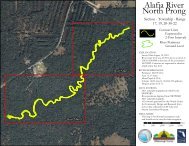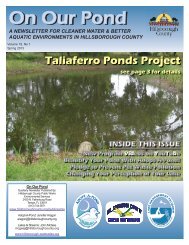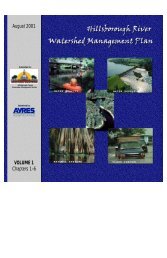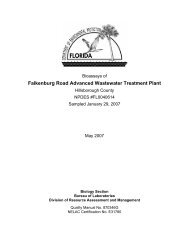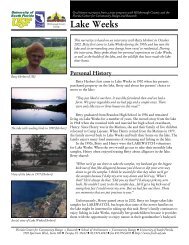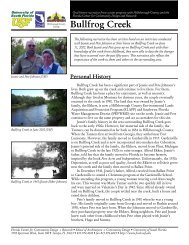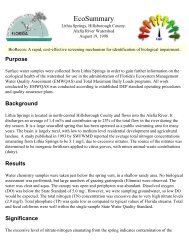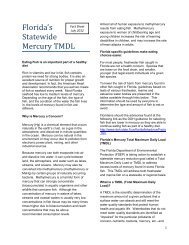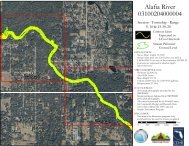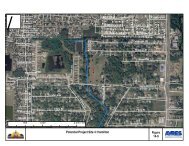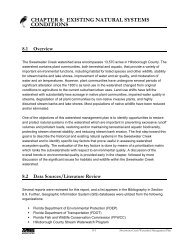Rocky Brushy Creek Watershed Mgmt. Plan (2007) -- Part 2
Rocky Brushy Creek Watershed Mgmt. Plan (2007) -- Part 2
Rocky Brushy Creek Watershed Mgmt. Plan (2007) -- Part 2
Create successful ePaper yourself
Turn your PDF publications into a flip-book with our unique Google optimized e-Paper software.
CHAPTER 88.5.4 Biological Indicators of Ecosystem HealthThe ability to evaluate the “health” of an ecosystem can be extremely complex due to the variabilityof chemical, physical, and meteorological processes that occur over time and space and also thediversity of habitat types that may be present within a watershed. One ongoing program is currentlyevaluating measures of ecosystem health--FDEP’s Biological Reconnaissance (BioRecon)program.The FDEP’s bioassessment program involves field sampling of aquatic biological communities tocharacterize community structure (i.e. diversity, pollution tolerance). The BioRecon programincludes measurements of water quality indicators such as dissolved oxygen, evaluating habitatconditions, and determining the health of aquatic insect communities. Many common insects spendtheir juvenile life within aquatic systems including dragonflies, mayflies, beetles, black flies, andmosquitoes. These organisms show the effects of physical habitat alterations, point and nonpointsource contaminants, and cumulative pollutants over their life cycle. To determine if a communityhas been negatively impacted by human activities, data are compared to reference communities(believed to be natural or relatively unimpacted by humans).The BioRecon program has not collected macroinvertebrate data in the <strong>Rocky</strong> <strong>Creek</strong> - <strong>Brushy</strong><strong>Creek</strong> watershed. The BioRecon procedure is a screening tool that evaluates three metricsincluding: the total number of macroinvertebrate taxa; number of Ephemeroptera (mayflies),Plecoptera (stoneflies), and Trichoptera (caddisflies) or EPT; and a Florida Index which representstaxa intolerant of stream perturbations. The sampling methodology involves three sweeps of a dipnet for a given stream sampling location and the identification of all organisms within the net.Scores for three categories are tabulated based on this data and if two of three exceed thresholdvalues the stream is rated as “healthy,” if less than two meet the thresholds then the stream israted as “suspected impaired” or “impaired. While useful for the Hillsborough River <strong>Watershed</strong><strong>Plan</strong>, the BioRecon data cannot give an assessment of watershed health in <strong>Rocky</strong> <strong>Creek</strong> - <strong>Brushy</strong><strong>Creek</strong> watershed.8.5.5 Strategic Habitat Conservation AreasIn 1994, the FWC published Closing the Gaps in Florida’s Wildlife Habitat Conservation System,which identifies habitats that must be conserved and managed to ensure the survival of keycomponents of Florida’s biological diversity. The primary objectives of the report are:1. to identify habitat areas that are essential to the survival of rare and declining species notadequately protected by the current system of conservation areas;2. to identify areas that are important to several globally endangered species of plants,animals, and plant communities; and3. to identify regional areas of high biological diversity to assist in local land use planning.The FWC utilized land cover and vegetation data, public land boundaries, and documentedoccurrences of species and communities to identify Strategic Habitat Conservation Areas (SHCA).8-29<strong>Rocky</strong>/<strong>Brushy</strong> <strong>Creek</strong> <strong>Watershed</strong> Management <strong>Plan</strong>



